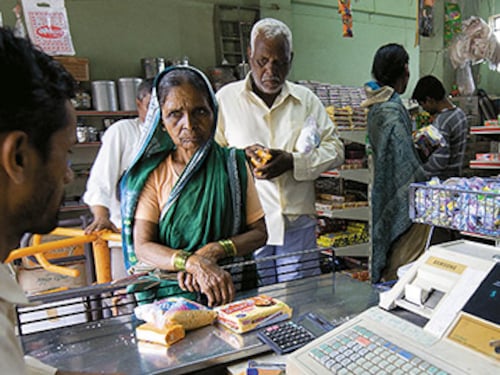Rural Consumers Will Hold the Key To Stocks' Success
Stocks are likely to do well thanks to them and steady FII equity flows


From a macroeconomic perspective, 2012 for India was close to the worst that could have been forecasted in late 2011. Back then, it was called sensationalist to forecast a 5 percent GDP growth, a mid-50s steady-state value for the rupee against the US dollar, a sticky 7 percent-plus wholesale price inflation, close to double-digit consumer price inflation and almost no rate cuts from the RBI. It was feared that if these came to pass, the equity markets would crash.
Each of the above happened, and yet the Nifty is up 27 percent for the year, and FII equity flows are the second highest ever (after 2010).
The answer to this seeming conundrum lies overseas. It was the global liquidity squeeze driven by fears of a Euro break-up that pushed down the Indian market in late 2011. The success of the European Central Bank’s Long-Term Refinancing Operations caused this liquidity to come rushing back at the beginning of 2012, pushing up stock markets sharply, in particular markets of capital-deficient economies like India’s. As the year dragged on and economic and earnings forecasts continued to get revised downwards, Indian equities languished for several months. Then in September, hope met flows: As the US Federal Reserve embarked on quantitative easing (QE) 3, investors chasing yield were pushed into riskier assets globally, and coincidentally the United Progressive Alliance (UPA) government kick-started the much-delayed reforms process. India was the only emerging market willing to dramatically change its ways and capital flowed in, boosting the market.
The actions of global Central banks are, hence, one of the most important factors to look out for when forming a view on broader indices in 2013. With growth in the developed markets expected to stay anaemic (though better than in 2012), and Central banks continuing to push the envelope on QE, FII equity inflows are likely to stay strong during the course of the year.
With Central banks in the US, the UK, EU and Japan undertaking bond purchases by printing money, yields on these bonds are likely to stay low for a while. The move by sovereign wealth funds as well as pension and insurance funds into riskier assets like emerging market equities therefore may continue. Over the past 15 years, India has received almost a fifth of all FII equity flows to emerging markets. In 2012, India got almost half of all FII equity flows to Asia ex-Japan, China and Malaysia.
These flows are relatively independent of local near-term economic vicissitudes and seem to track medium- to long-term prospects for the country. In the past 15 years, FII equity flows to India have turned meaningfully negative only when there was a disruption in global trade and/or a global liquidity squeeze. Not when India saw meaningful political uncertainty or stagnating growth and high inflation.
The above analysis makes it seem as if local factors or earnings forecasts do not matter at all. They very much do, as few investors trade the broader indices most choose sectors and stocks. In the past few years, as the investment cycle turned downwards, consumption-related themes have outperformed and investment-related themes have underperformed. Will this change in 2013? There are three key determinants in our view.
The first deals with ‘reforms’, the view being that the government passing important legislation as well as taking administrative steps will re-start the investment cycle. However, a review of reforms undertaken since 1991 suggests that it can take six to eight years from intent to impact. That is too long a period for the equity markets to price in now. Moreover, as the 2014 general elections draw near, market consensus is that the 2013 budget will be the end of the reformist stage, and the Congress will get into election mode again.
The second determinant deals with the economic cycle. The visible slowdown in wholesale price inflation in the past few months has driven hopes of the RBI starting a prolonged rate-cutting phase. A meaningful fall in the repo rate should help rate-sensitive sectors like banks and automotive companies, companies with weak balance sheets and those at the margin start to make new projects viable. However, with government expenditures sticky and revenues cyclically weak, deficits and consequently deficit monetisation are likely to stay high. This may keep inflation at high levels and limit the RBI’s ability to cut rates. In our view, slow growth and high inflation are likely to continue. Further, high interest rates are not the primary reason for the slowdown in the investment cycle—that has to do with shortages of raw materials or sector-specific demand-supply mismatches, like in metals.
The third determinant deals with the pace and nature of consumption growth. Agricultural wage growth has outstripped inflation since March 2008, and as late as September 2012 it was still growing at 20 percent-plus rates. This is far higher than the mid-teens growth seen for blue-collar workers, and much ahead of the compensation for entry-level software engineers that has remained unchanged in the past five years. Consumption, especially at lower levels of the income pyramid, is therefore likely to stay strong.
Thus, the macroeconomic trends of the past few years are likely to continue in 2013: Steady FII equity flows that boost valuations for stocks, a weak investment cycle, and steady consumption growth, especially at low-income levels. With the valuation gap between consumption- and investment-driven stocks having narrowed in 2012, investors may be well-advised to stay invested in consumer, health care and exporter stocks. The Indian market also abounds in strong bottom-up investment stories in the small and mid-cap space: Well-managed relatively undiscovered companies benefiting from secular trends like ‘rural urbanisation’, financial inclusion, or the weaker rupee. 
Neelkanth Mishra
Profile: He is the India Equity Strategist for Credit Suisse, and is rated among the best analysts in India in Institutional Investor and AsiaMoney polls.
Known For: His deep understanding of various sectors and well articulated research reports.
First Published: Jan 17, 2013, 06:03
Subscribe Now